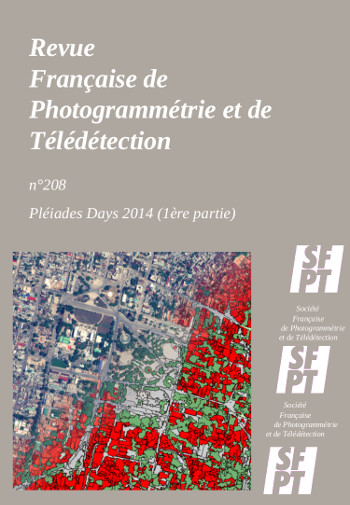Mathematical morphology pre-processing for enhanced segmentation of heterogeneous spatial regions
DOI:
https://doi.org/10.52638/rfpt.2014.133Keywords:
segmentation, spatial region, mathematical morphologyAbstract
The very high spatial resolution of Pleiades images allows for the detection of small spatial objects such as buildings or isolated trees. However, the delineation of spatial regions, defined as associations between different spatial objects (such as open canopy forests or urban areas), becomes more challenging with the high level of details. On one hand, automated image segmentation algorithms often yield over-segmented polygons due to due to the high spectral heterogeneity of those regions. On the other hand, manual delineation was shown to end up with a significant bias from the interpreter and even a lack of consistency when the same person works more than one hour on the same task. In this study, we aimed at implementing a new filter to increase the contextual consistency of automated segmentation while preserving the geometric precision of the delineation of spectrally homogeneous spatial regions. A new mathematical morphology approach is proposed, which consists in applying a set of rules to an image based on the presence of absence of vegetation pixels within a structuring element. Two composite filters were then built based on the new filters. The opening filter removes isolated vegetation patches inside heterogeneous spatial regions, while the closing filter fills the gaps between those vegetation patches. The filters have been tested on a Pleiades images located in Belgium around the city of Leuven. A composite image was then created with the NIR and Red filtered bands stacked with the original image bands. The composite and the original bands were then segmented using e-Cognition software with the same parameters. The results show that the segmentation of the filtered images is spatially more consistent than the segmentation based on the unfiltered image. The over-segmentation is reduced in the heterogeneous areas, while the precision of the delineation is improved. The objects derived from the filtered images are thus more appropriate for the monitoring of spatial regions.Downloads
Download data is not yet available.
Downloads
Published
2014-09-08
How to Cite
Radoux, J., & Defourny, P. (2014). Mathematical morphology pre-processing for enhanced segmentation of heterogeneous spatial regions. Revue Française de Photogrammétrie et de Télédétection, (208), 33–38. https://doi.org/10.52638/rfpt.2014.133
Issue
Section
Articles
License
Copyright (c) 2022 Julien Radoux, Pierre Defourny

This work is licensed under a Creative Commons Attribution 4.0 International License.
Authors retain copyright and grant the journal right of first publication with the work simultaneously licensed under a Creative Commons Attribution (CC-BY) 4.0 License that allows others to share the work with an acknowledgment of the work’s authorship and initial publication in this journal.






